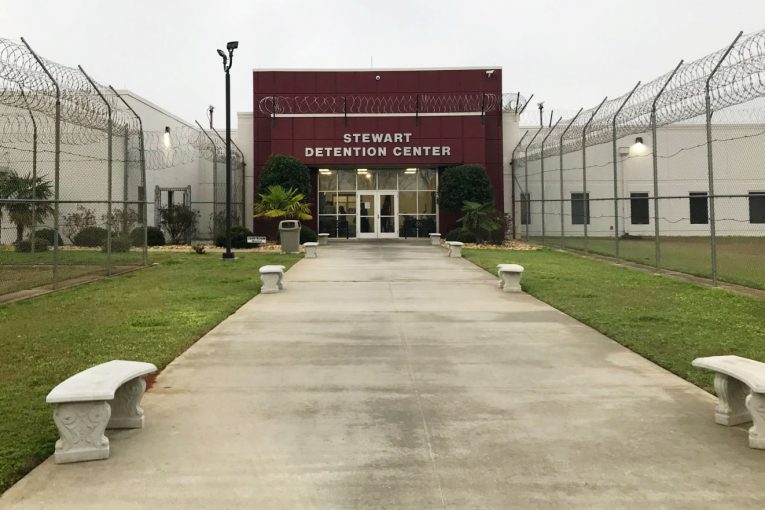

By Natalia Ruvalcaba and Michele Chadwick
WASHINGTON D.C. – U.S. Immigration and Customs Enforcement (ICE) incarcerates more than 20,000 people daily in a nationwide network with about 200 detention centers.
And the American Civil Liberties Union (ACLU) believes that “ this system of mass incarceration of immigrants should be dismantled — it’s unnecessary and inhumane.”
Additionally, the ACLU believes that it is ICE’s responsibility to create an oversight system that is actually effective at detecting, addressing, and deterring abuse of detained people for as long as they maintain and operate this detention network.
The ACLU’s recent analysis of ICE inspection documents determines “ICE’s inspection system remains ineffective at identifying violations by detention facilities and ensuring compliance with detention standards, allowing facilities with clear records of poor conditions, including some of the deadliest facilities, such as the Stewart Detention Facility in Georgia, to evade accountability.”
ACLU notes that nearly every detention facility must adhere to detention standards to establish consistent conditions of confinement and ensure minimum standards of care and safety for the people detained by ICE. Compliance with these standards is monitored through external audits performed by a private contractor called The Nakamoto Group.
But the ACLU said Nakamoto’s ability to serve as ICE’s auditor is controversial. In 2018, the Department of Homeland Security Office of Inspector General (OIG) found that Nakamoto’s “inspection  practices are not consistently thorough.”
practices are not consistently thorough.”
The ACLU report notes employees within ICE reportedly told OIG that Nakamoto inspectors “breeze by the [detention] standards” and do not “have enough time to see if the [facility] is actually implementing the policies.” Additionally, employees described the inspections as “useless” and “very, very, very difficult to fail.” The House Homeland Security Committee issued a similarly scathing critique of Nakamoto. In September 2020, the committee’s majority staff reported that Nakamoto “has demonstrated a lack of credibility and competence.”
The ACLU claims to have reviewed “every inspection report that Nakamoto issued in 2021 and found that little has changed.” The ACLU maintains that the same problems identified by OIG and the House Homeland Security Committee in 2020 continue to plague Nakamoto’s inspections.
The first issue, suggest the ACLU, with Nakamoto’s inspections is their fail rate – virtually no facility fails its inspections.
The ACLU claims that “even facilities that are deficient in 30 or more components receive a rating of “meets standards.” Moreover, the ACLU found that inspections fail to account for clear indications of poor conditions.
The ACLU cites Nakamoto’s inspection of the Stewart Detention Center in Georgia as an example. According to Nakamoto’s audit, they found that the facility “meets standards,” identified only one deficient component in the standard of “Correspondence and Other Mail,” and stated that “there were no areas of concern or significant observation.”
Despite these claims, Stewart has accounted for the most deaths within any ICE facility dating back to May of 2017, said the ACLU, noting that within these past four years, eight detained people have died while in custody, including 57-year-old Felipe Montes of Mexico. Montes’ death happened just weeks before the inspection made by Nakamoto, which in no way indicated that there were worries related to medical or mental health care as well as concerns about COVID-19.
Notably, Nakamoto’s inspections are, without fail, pre-announced, noted the ACLU, meaning that audits are often not clear indicators of the facility’s true nature, as there is time to obscure reality. Pre-announced inspections authorize facilities to mask their inadequacies in order to pass the check. Important to record is the responsibility that ICE maintains for this issue, as they have implemented such condition into the inspector’s contract.
Nakamoto’s inspections persist in error as they are commonly conducted in non-private environments, leading those in custody to feel less comfortable voicing their true experiences. It was also discovered that the complaints of detainees are oftentimes not taken with serious concern, said the ACLU.
Lastly, Nakamoto inspectors seem to uphold the portrayals made by the jailers and ICE officers, instead of making sure something is true, the ACLU study revealed, and in the case of Prairieland Detention Center in Texas, an individual placed into ICE’s structuring of solitary confinement, or the Special Management Unit (SMU), “stated he had not seen an ICE officer while housed in the SMU.”
However, despite this claim made by an individual in custody, Nakamoto noted that “ICE officers routinely visit the SMU,” since the facility claimed such assertion, in spite of the fact that “[d]ocumentation that an ICE officer had visited this particular detainee was not available,” the ACLU report suggests.
From the examples above and others, it is evident that the inspections by Nakamoto are marked by falsehoods, charged the ACLU.
Claimants from Congress have already noted, the conclusion of DHS’s contract with Nakamoto’s contract is long overdue.
Though, all ICE’s issues cannot be directed back to Nakamoto.
The ACLU reminds that ICE is responsible for upholding its own standards and must hold facilities liable when these standards are breached. Facilities must undergo conscientious inspections and be devoted to the levying of sanctions, such as ceasing contracts for facilities that fail inspection, in order to guarantee meaningful processes and an adequate monitoring system.
Transparency is also something deserving for the public, as the ACLU maintains, urging the public is made aware of the detention facilities and the standards of which are being broken, and if repercussions are being taken.
It is not merely enough to guarantee productive oversight and clarity.
ICE’s predecessor, the Immigration and Naturalization Service, when first establishing its standards, told the New York Times that its intent was to “provide safe, secure and humane conditions of detention.” Though this premise is founded on the concept that safety and humaneness can be found within the constraints of detention when it can’t, insists the ACLU.
The civil rights groups said the multitude of records that depict ICE’s abuse, neglect, and death reveal that the ICE “detention machine” must be shuttered.
